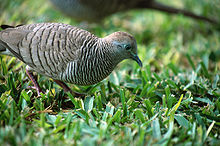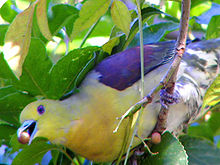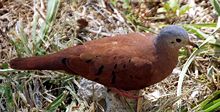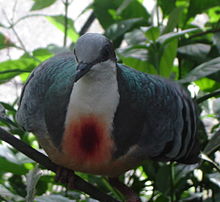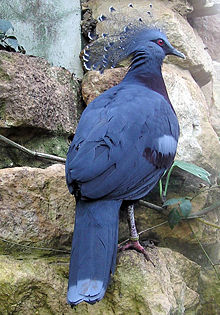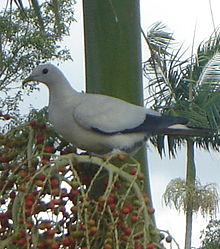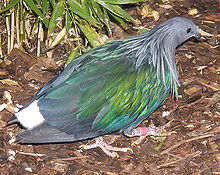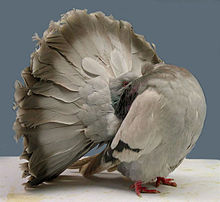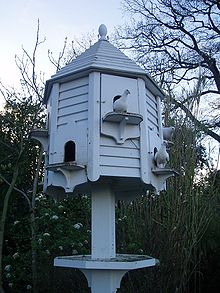- Columbidae
-
"Pigeon" and "Dove" redirect here. For other uses, see Pigeon (disambiguation) and Dove (disambiguation).For pigeon species familiar to people around the world, see Feral Pigeon, Domestic Pigeon, and Rock Pigeon.
Pigeons and Doves
Temporal range: Early Miocene – Recent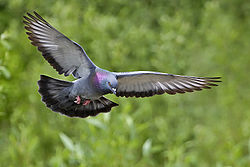
Feral Pigeon (Columba livia domestica) in flight Scientific classification Kingdom: Animalia Phylum: Chordata Subphylum: Vertebrata Class: Aves Order: Columbiformes Family: Columbidae
Illiger, 1811Subfamilies see article text

Geographic range of the Columbidae Family Pigeons and doves constitute the bird family Columbidae within the order Columbiformes, which include some 300 species of near passerines. In general terms "dove" and "pigeon" are used somewhat interchangeably. In ornithological practice, there is a tendency for "dove" to be used for smaller species and "pigeon" for larger ones, but this is in no way consistently applied, and historically the common names for these birds involve a great deal of variation between the terms "dove" and "pigeon." This family occurs worldwide, but the greatest variety is in the Indomalaya and Australasia ecozones. Young doves and pigeons are called "squabs."
Pigeons and doves are stout-bodied birds with short necks, and have short slender bills with a fleshy cere. The species commonly referred to just as "pigeon" is the Feral Rock Pigeon, common in many cities.
Doves and pigeons build relatively flimsy nests from sticks and other debris, which may be placed in trees, on ledges or on the ground, depending on species. They lay one or two eggs, and both parents care for the young, which leave the nest after 7 to 28 days.[1] Doves feed on seeds, fruit and plants. Unlike most other birds (but see flamingo), the doves and pigeons produce "crop milk", which is secreted by a sloughing of fluid-filled cells from the lining of the crop. Both sexes produce this highly nutritious substance to feed to the young.
Contents
Biology
Morphology
Pigeons and doves exhibit considerable variations in size. The largest species are the crowned pigeons of New Guinea, which are nearly turkey-sized, at a weight of 2-4 kilograms (4.4-8.8 lbs.) The smallest are the New World ground-doves of the genus Columbina, which are the same size as a House Sparrow and weigh as little as 22 grams.[2] With a total length of more than 50 centimeters (19 in) and weight of almost a kilo (2 lb), the largest arboreal species is the Marquesan Imperial Pigeon, while the Dwarf Fruit Dove, which may measure as little as 13 centimeters (5.1 in), has a marginally smaller total length than any other species from this family.[2] Smaller species tend to be known as doves, while larger species as pigeons, but there is no taxonomic basis for distinguishing between the two.[2]
Overall, the Columbidae tend to have short bills and legs, small heads on large compact bodies. The wings are large and have low wing loadings; pigeons have strong wing muscles (wing muscles comprise 31–44% of their body weight) and are amongst the strongest fliers of all birds. They are also highly maneuverable in flight.
The plumage of the family is variable. Granivorous species tend to have dull plumage, with a few exceptions, whereas the frugivorous species have brightly coloured plumage.[2] The Ptilinopus fruit doves are some of the brightest coloured pigeons, with the three endemic species of Fiji and the Indian Ocean Alectroenas being amongst the brightest coloured. Pigeons and doves may be sexually monochromatic or dichromatic. In addition to bright colours pigeons may sport crests or other ornamentation.
Like some other birds, the Columbidae have no gall bladder.[3] Some medieval naturalists concluded that they have no gall, which in the medieval theory of the four humours explained the allegedly sweet disposition of doves.[4] In fact, however, they do have gall (as Aristotle already realised), which is secreted directly into the gut.[5]
Distribution and habitat
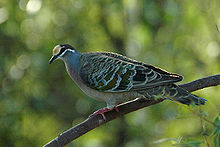 The Common Bronzewing has a widespread distribution across all of Australia and lives in most habitat types except dense rainforest and the driest deserts
The Common Bronzewing has a widespread distribution across all of Australia and lives in most habitat types except dense rainforest and the driest deserts
Pigeons and doves are distributed everywhere on Earth, except for the driest areas of the Sahara Desert, Antarctica and its surrounding islands and the high Arctic. They have colonised most of the world's oceanic islands, reaching eastern Polynesia and the Chatham Islands in the Pacific, Mauritius, the Seychelles and Réunion in the Indian Ocean, and the Azores in the Atlantic Ocean.
The family has adapted to most of the habitats available on the planet. The largest number of species are found in tropical forests and woodlands, where they may be arboreal, terrestrial or semi-terrestrial. Various species also inhabit savannas, grasslands, deserts, temperate woodlands and forests, mangrove forests, and even the barren sands and gravels of atolls.
Some species have large natural ranges. The Eared Dove ranges across the entirety of South America from Colombia to Tierra Del Fuego, the Eurasian Collared Dove has a massive (if discontinuous) distribution from Britain across Europe, the Middle East, India, Pakistan and China, and the Laughing Dove across most of sub-Saharan Africa as well as India,Pakistan and the Middle-east. Other species have a tiny restricted distribution; this is most common in island endemics. The Whistling Dove is endemic to the tiny Kadavu Island in Fiji, the Caroline Ground-dove is restricted to two islands, Truk and Pohnpei in the Caroline Islands and the Grenada Dove is restricted to Grenada in the Caribbean. Some continental species also have tiny distributions; for example the Black-banded Fruit Dove is restricted to a small area of the Arnhem Land of Australia, the Somali Pigeon is restricted to a tiny area of northern Somalia, and Moreno's Ground Dove is restricted to the area around Salta and Tucuman in northern Argentina.[2]
The largest range of any species is that of the Rock Dove. The species had a large natural distribution from Britain and Ireland to northern Africa, across Europe, Arabia, Central Asia, India, the Himalayas and up into China and Mongolia. The range of the species increased dramatically upon domestication as the species went feral in cities around the world. The species is currently resident across most of North America, and has established itself in cities and urban areas in South America, sub-Saharan Africa, South East Asia, Japan, Australia and New Zealand. The species is not the only pigeon to have increased its range due to actions of man; several other species have become established outside of their natural range after escaping captivity, and other species have increased their natural ranges due to habitat changes caused by human activities.[2]
Diet
Seeds and fruit form the major component of the diet of pigeons and doves. In fact, the family can be divided into the seed eating or granivorous species (subfamily Columbinae) and the fruit eating or frugivorous species (the other four subfamilies). The granivorous typically feed on seed found on the ground, whereas the species that feed on fruit and mast tend to feed in trees. There are morphological adaptations that can be used to distinguish between the two groups, granivorous species tend to have thick walls in the gizzards, whereas the frugivores tend to have thin walls. In addition fruit eating species have short intestines whereas those that eat seeds have longer ones. Frugivores are capable of clinging to branches and even hang upside down to reach fruit.[2]
In addition to fruit and seeds a number of other food items are taken by many species. Some species, particularly the ground-doves and quail-doves take a large number of prey items such as insects and worms. One species, the Atoll Fruit Dove is specialised in taking insect and reptile prey. Snails, moths and other insects are taken by White-crowned Pigeons, Orange Doves and Ruddy Ground Doves.[2]
Evolutionary speculations
Pigeons selectively eating wheat instead of rice grains
This family is a highly coherent group with no members showing obvious links with other bird families, or vice versa. The dodo and solitaires are clearly related, as discussed below, but equally lacking in obvious links with other bird families. The limited fossil record also consists only of unequivocal Columbidae species. Links to the sandgrouse and parrots have been suggested, but resemblances to the first group are due to convergent evolution[citation needed] and the second depend on the parrot-like features of the Tooth-billed Pigeon. However, the distinctive features of that bird seem to have arisen from its specialized diet rather than a real relationship to the parrots[citation needed].
The family is usually divided into five subfamilies, but this is probably inaccurate. For example, the American ground and quail doves which are usually placed in the Columbinae seem to be two distinct subfamilies.[6] The order presented here follows Baptista et al. (1997) with some updates (Johnson & Clayton 2000, Johnson et al. 2001, Shapiro et al. 2002).
The arrangement of genera and naming of subfamilies is in some cases provisional because analysis of different DNA sequences yield results that differ, often radically, in the placement of certain (mainly Indo-Australian) genera. This ambiguity, probably caused by long branch attraction, seems to confirm that the first pigeons evolved in the Australasian region, and that the "Treronidae" and allied forms (crowned and pheasant pigeons, for example) represent the earliest radiation of the group.
As the Dodo and Rodrigues Solitaire are in all likelihood part of the Indo-Australian radiation that produced the 3 small subfamilies mentioned above with the fruit doves and -pigeons (including the Nicobar Pigeon), they are here included as a subfamily Raphinae, pending better material evidence of their exact relationships.
Exacerbating these issues, columbids are not well represented in the fossil record. No truly primitive forms have been found to date. The genus Gerandia has been described from Early Miocene deposits of France, but while it was long believed[citation needed] to be a pigeon it is more likely a sandgrouse[citation needed]. Fragmentary remains of a probably "ptilinopine" Early Miocene pigeon were found in the Bannockburn Formation of New Zealand and described as Rupephaps; "Columba" prattae from roughly contemporary deposits of Florida is nowadays tentatively separated in Arenicolumba, but its distinctness from Patagioenas needs to be more firmly established. Apart from that, all other fossils belong to extant genera. For these, and for the considerable number of more recently extinct prehistoric species, see the respective genus accounts.
Genera
A list of all the species, sortable by common and scientific name, is at list of Columbidae species
Family Columbidae
- Subfamily Columbinae – typical pigeons & doves
- Genus Columba including Aplopelia – Old World pigeons (33-34 living species, 2-3 recently extinct)
- Genus Streptopelia including Stigmatopelia and Nesoenas[verification needed] – turtledoves (14-18 living species)
- Genus Patagioenas – American pigeons; formerly in Columba (17 species)
- Genus Ectopistes – Passenger Pigeon; formerly Leptotilinae (extinct; 1914)
- Genus Macropygia (10 species)
- Genus Reinwardtoena (3 species)
- Genus Turacoena (2 species)
- Subfamily N.N. – Bronzewings and relatives
- Genus Turtur – African wood-doves (5 species; tentatively placed here)
- Genus Oena – Namaqua Dove (tentatively placed here)
- Genus Chalcophaps (2 species)
- Genus Henicophaps (2 species)
- Genus Phaps (3 species)
- Genus Ocyphaps – Crested Pigeon
- Genus Geophaps (3 species)
- Genus Petrophassa – rock-pigeons (2 species)
- Genus Geopelia (3–5 species)
- Subfamily Leptotilinae – Zenaidine and quail-doves
- Genus Zenaida (7 species)
- Genus Leptotila (11 species)
- Genus Geotrygon – quail-doves (16 species)
- Genus Starnoenas – Blue-headed Quail-Dove
- Subfamily Columbininae – American ground doves
- Genus Columbina (7 species)
- Genus Claravis (3 species)
- Genus Metriopelia (4 species)
- Genus Scardafella – possibly belongs into Columbina (2 species)
- Genus Uropelia – Long-tailed Ground Dove
- Subfamily N.N. – Indopacific ground doves
- Genus Gallicolumba (16-17 living species, 3-4 recently extinct)
- Genus Trugon – Thick-billed Ground Pigeon
- Subfamily Otidiphabinae – Pheasant Pigeon
- Genus Otidiphaps – Pheasant Pigeon
- Subfamily Didunculinae – Tooth-billed Pigeon
- Genus Didunculus – Tooth-billed Pigeon
- Subfamily Gourinae – crowned pigeons
- Genus Goura (3 species)
- Subfamily N.N. ("Treroninae") – green and fruit doves and imperial pigeons
- Genus Ducula – imperial-pigeons (36 species)
- Genus Lopholaimus – Topknot Pigeon
- Genus Hemiphaga (2 species)
- Genus Cryptophaps – Sombre Pigeon
- Genus Gymnophaps – mountain-pigeons (3 species)
- Genus Ptilinopus – fruit doves (some 50 living species, 1-2 recently extinct)
- Genus Natunaornis – Viti Levu Giant Pigeon (prehistoric)
- Genus Drepanoptila – Cloven-feathered Dove
- Genus Alectroenas – blue pigeons (3 living species)
- Subfamily Raphinae – didines
- Placement unresolved
- Genus Caloenas – Nicobar Pigeon
- Genus Treron – green pigeons (23 species)
- Genus Phapitreron – brown doves (3 species)
- Genus Leucosarcia – Wonga Pigeon
- Genus Microgoura – Choiseul Crested Pigeon (extinct; early 20th century)
- Genus Dysmoropelia – Saint Helena Dove (extinct)
- Genus Bountyphaps - Henderson Island Archaic Pigeon (prehistoric)
Relationship with humans
As food
Several species of pigeon and dove are used as food, and probably any could be; the powerful breast muscles characteristic of the family make excellent meat. In Europe the Wood Pigeon is commonly shot as a game bird, while Rock Pigeons were originally domesticated as a food species, and many breeds were developed for their meat-bearing qualities. Mrs Beeton's Book of Household Management contains recipes for roast pigeon and pigeon pie, a popular inexpensive food in Victorian industrial Britain.[7]
The extinction of the Passenger Pigeon was at least partly due to shooting for use as food. According to the Tanakh, doves are kosher, and they are the only birds that may be used for a korban. Other kosher birds may be eaten, but not brought as a korban.
Military
The pigeon has contributed to both World War I and II, notably by the Australian, French, German, American, and UK forces. 32 Pigeons have been decorated with the Dickin Medal for war contributions, including Commando, G.I. Joe, Paddy, and William of Orange.
A grand ceremony was held in Buckingham Palace to commemorate a platoon of pigeons that braved the battlefields of Normandy to deliver vital plans to Allied forces on the fringes of Germany. Three of the actual birds that received the medals are on show in the London Military Museum so that well wishers can pay their respects.
Domestication
The Rock Pigeon has been domesticated for hundreds of years. It has been bred into several varieties kept by hobbyists, of which the best known is the homing pigeon or racing homer. Other popular breeds are tumbling pigeons such as the Birmingham Roller and fancy varieties that are bred for certain physical characteristics, such as large feathers on the feet or fan-shaped tails. Domesticated Rock Pigeons are also bred as Carrier pigeons, used for thousands of years to carry brief written messages, and Release Doves used in ceremonies.
In religion
In the Hebrew Bible, doves or young pigeons are acceptable burnt offerings for those who can't afford a more expensive animal. In the book of Genesis, Noah sent out a dove after the great flood in order to determine how far the floodwaters had receded. Dove is also a term of endearment in the Song of Songs and elsewhere.
Jesus's parents sacrifice doves on his behalf after his circumcision (Luke 2:24). Later the Holy Spirit descended upon Jesus at his baptism like a dove (Matthew 3:16), and subsequently the "peace dove" became a common Christian symbol of the Holy Spirit.
In Islam, doves and the pigeon clan in general are respected and favoured because they are believed to have assisted the final prophet of Islam, Muhammad, in distracting his enemies outside the cave of Thaw'r in the great Hijra.
Threats and conservation
While many species of pigeons and doves have benefited from human activities and have increased their ranges, many other species have declined in numbers and some have become threatened or even succumbed to extinction. Amongst the 10 species that have become extinct since 1600 (the conventional date for estimating modern extinctions) are two of the most famous extinct species, the Dodo and the Passenger Pigeon. The Passenger Pigeon was exceptional for a number of reasons, along with being the only pigeon species to have gone extinct in modern times that was not an island species. It was once the most numerous species of bird on Earth. Its former numbers are difficult to estimate but one ornithologist, Alexander Wilson, estimated that one flock he observed contained over two billion birds. The decline of the species was abrupt; in 1871 a breeding colony was estimated to contain over a hundred million birds, yet the last individual in the species was dead by 1914. Although habitat loss was a contributing factor, the species is thought to have been massively overhunted, being used as food for slaves and, later, the poor in the United States throughout the 19th century.
The Dodo, and its extinction, was more typical of the extinctions of pigeons in the past. Like many species that colonize remote islands with few predators it lost much of its anti-predator behaviour, along with its ability to fly. The arrival of people, along with a suite of other introduced species such as rats, pigs and cats, quickly spelt the end for this species and all the other island forms that have become extinct.
Around 59 species of pigeon and dove are threatened with extinction today, this is 19% of all species.[8] Most of these are tropical and live on islands. All of the species threatened today are threatened by introduced predators, habitat loss and hunting, or a combination of these factors. In some cases they may be extinct in the wild, as is the Socorro Dove of Socorro Island, Mexico, which was driven to the extinction by habitat loss and introduced feral cats.[9] In some areas a lack of knowledge means that the true status of a species is unknown; the Negros Fruit Dove has not been seen since 1953 and may or may not be extinct, and the Polynesian Ground Dove is classified as critically endangered as it is unknown whether it survives or not on remote islands in the far west of the Pacific Ocean.
Various conservation techniques are employed to prevent these extinctions. These include laws and regulations to control hunting pressure, the establishment of protected areas to prevent further habitat loss, the establishment of captive populations for reintroduction back into the wild (ex situ conservation) and the translocation of individuals to suitable habitat to create additional populations.
See also
- Alphabetical species list
- Gamasoidosis
- War pigeon
- Peace dove
- Pigeon control
- Doves as symbols
References
- Baptista, L. F.; Trail, P. W. & Horblit, H. M. (1997): Order Columbiformes. In: del Hoyo, J.; Elliott, A. & Sargatal, J. (editors): Handbook of birds of the world, Volume 4: Sandgrouse to Cuckoos. Lynx Edicions, Barcelona. ISBN 84-87334-22-9
- Blechman, Andrew, Pigeons: The Fascinating Saga of the World's Most Revered and Reviled Bird (Grove Press 2007) ISBN 978-0-8021-4328-0
- Gibbs, Barnes and Cox, Pigeons and Doves (Pica Press 2001) ISBN 1-873403-60-7
- Johnson, Kevin P. & Clayton, Dale H. (2000): Nuclear and Mitochondrial Genes Contain Similar Phylogenetic. Signal for Pigeons and Doves (Aves: Columbiformes). Molecular Phylogenetics and Evolution 14(1): 141–151. PDF fulltext
- Johnson, Kevin P.; de Kort, Selvino; Dinwoodey, Karen, Mateman, A. C.; ten Cate, Carel; Lessells, C. M. & Clayton, Dale H. (2001): A molecular phylogeny of the dove genera Streptopelia and Columba. Auk 118(4): 874-887. PDF fulltext
- Shapiro, Beth; Sibthorpe, Dean; Rambaut, Andrew; Austin, Jeremy; Wragg, Graham M.; Bininda-Emonds, Olaf R. P.; Lee, Patricia L. M. & Cooper, Alan (2002): Flight of the Dodo. Science 295: 1683. doi:10.1126/science.295.5560.1683 (HTML abstract) Supplementary information
Footnotes
- ^ Crome, Francis H.J. (1991). Forshaw, Joseph. ed. Encyclopaedia of Animals: Birds. London: Merehurst Press. pp. 115–116. ISBN 1-85391-186-0.
- ^ a b c d e f g h Baptista, L. F.; Trail, P. W. & Horblit, H. M. (1997): Family Columbidae (Doves and Pigeons). In: del Hoyo, J.; Elliott, A. & Sargatal, J. (editors): Handbook of birds of the world, Volume 4: Sandgrouse to Cuckoos. Lynx Edicions, Barcelona. ISBN 84-87334-22-9
- ^ Lee R. Hagey et al; Biliary bile acids of fruit pigeons and doves(Columbiformes); Journal of Lipid Research; PDF online, last checked 2010-01-31
- ^ The Medieval Bestiary, Doves, last checked 2010-01-31
- ^ Thomas Browne, 1646; Pseudodoxia Epidemica III.iii; 1672 edition available olnline, last checked 2010-01-31
- ^ Basically, the conventional treatment had 2 large subfamilies, one for the fruit doves, imperial pigeons and fruit-pigeons, and another for nearly all of the remaining species. Additionally, there were 3 monotypic subfamilies, one each for the genera Goura, Otidiphaps and Didunculus. The old subfamily Columbinae consists of 5 distinct lineages, whereas the other 4 groups are more or less accurate representations of the evolutionary relationships.
- ^ http://www.mrsbeeton.com/40-chapter40.html
- ^ Walker, J. (2007) "Geographical patterns of threat among pigeons and doves (Columbidae)" Oryx 41 (3): 289-299.
- ^ BirdLife International (2009). "Socorro Dove Zenaida graysoni". Data Zone. BirdLife International. http://www.birdlife.org/datazone/species/index.html?action=SpcHTMDetails.asp&sid=2555&m=0. Retrieved 26 June 2009.
External links
- Columbidae.org.uk Conservation of pigeons and doves
- Dove videos on the Internet Bird Collection
- Dove sounds
Categories:- Bird families
- Columbidae
- Game birds
- Heraldic birds
- National symbols of Cyprus
- National symbols of Fiji
- National symbols of Guinea
- National symbols of Tonga
- Peace symbols
- Subfamily Columbinae – typical pigeons & doves
Wikimedia Foundation. 2010.


